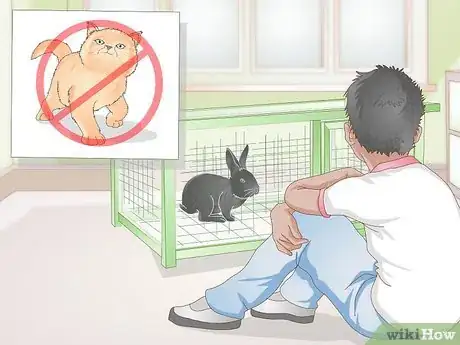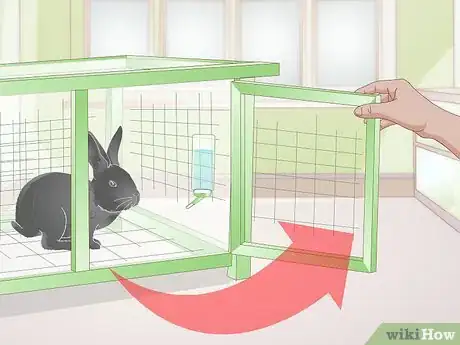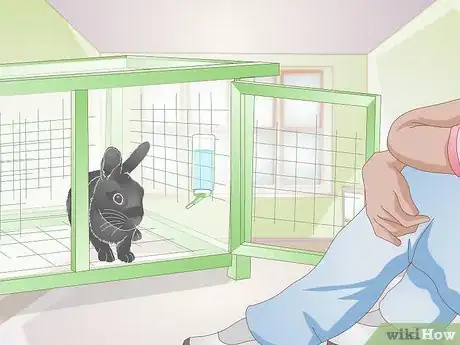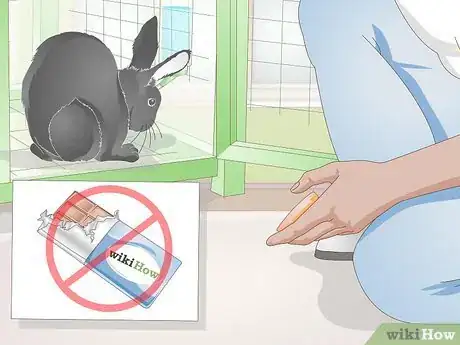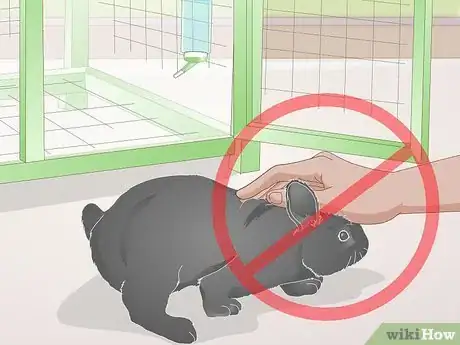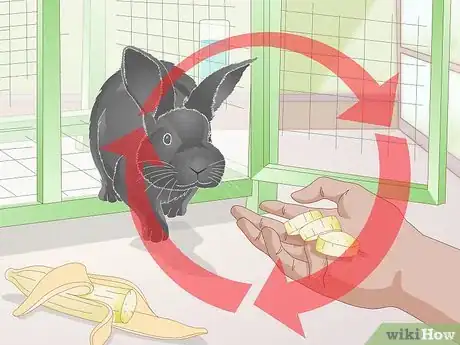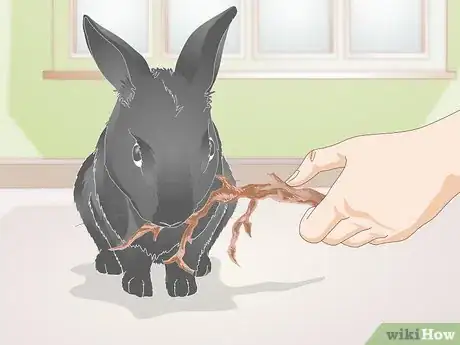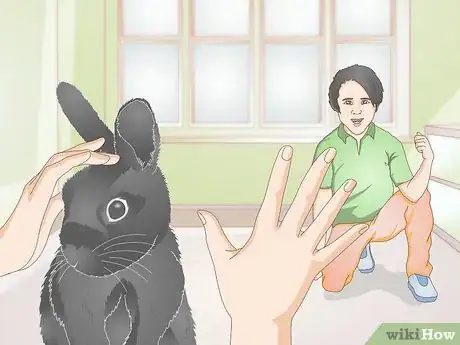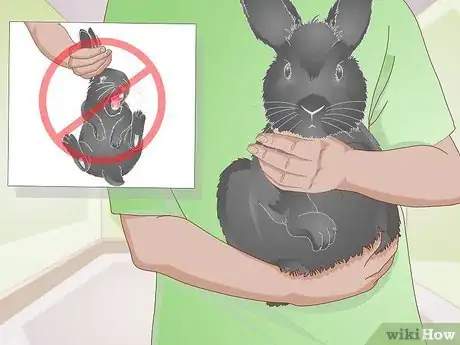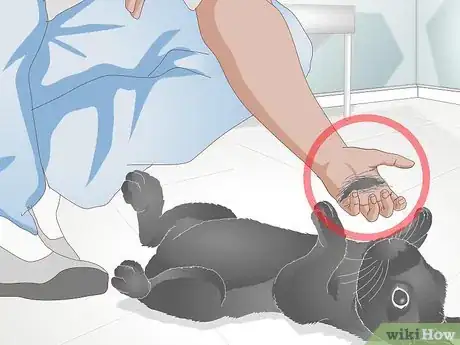This article was co-authored by Pippa Elliott, MRCVS. Dr. Elliott, BVMS, MRCVS is a veterinarian with over 30 years of experience in veterinary surgery and companion animal practice. She graduated from the University of Glasgow in 1987 with a degree in veterinary medicine and surgery. She has worked at the same animal clinic in her hometown for over 20 years.
wikiHow marks an article as reader-approved once it receives enough positive feedback. In this case, 89% of readers who voted found the article helpful, earning it our reader-approved status.
This article has been viewed 259,498 times.
It’s no easy task to earn your rabbit’s trust. Though they are inquisitive creatures, their instinct is to run from anything large and noisy, especially if that something is attempting to pick it up. In terms of personality, expect your rabbit to be shy until the two of you have been able to spend some quality time together. Ultimately, you will likely have to adjust your own behavior to ensure that your rabbit comes to recognize you as a trustworthy friend.[1]
Steps
Getting to Know Your Rabbit
-
1Spend time together alone. Rabbits can easily be startled or overwhelmed by the noise and movement of multiple people. Similarly, other pets are likely to terrify a pet rabbit until they’re used to their presence. In order to start earning your rabbit’s trust, join your rabbit in the room where it lives without any other humans or animals present.[2]
-
2Open the rabbit’s hutch at floor level. A door out of the hutch at floor level is especially important. You want to avoid reaching in and out of the rabbit’s hutch, as this is the space where they need to feel safe. Accordingly, give your rabbit the freedom to choose when they come out of their hutch by choosing a hutch with a door that will allow them to leave and re-enter comfortably.[3]Advertisement
-
3Let your rabbit come to you. After opening the hutch, take a few steps away. Lie or crouch on the floor away from the hutch. Wait for your rabbit to approach. Stay calm, as your rabbit may sense your frustration or impatience and become frightened. Rest assured that your rabbit’s curiosity will cause them to come say hello.[4]
-
4Offer a treat. To motivate the rabbit to come out and spend time with you, offer a treat. Place the treat in the palm of your outstretched hand. Go with small pieces of carrots, apples, or bananas. A pinch of oats may also be enticing to your rabbit.[5]
- Veggies and fruits should not amount to more than 10% of the rabbit’s total diet. Rabbits should eat mostly hay.[6]
- Never feed your rabbit anything with chocolate, caffeine, or high amounts of sugar or fat.
-
5Be patient. At first, this process will be rather slow. Don’t expect to open the hutch, lie down, and immediately have a rabbit eating out of your hand. The rabbit must feel safe enough to leave its hutch. Accordingly, they must determine that you are not a threat before they will approach. Send the message that you are a friend by staying calm, with a relaxed posture and slow, infrequent movement.[7]
- This process may take an hour or so. Your rabbit’s natural curiosity will eventually compel them to come and investigate.
-
6Hold off on touching. As your rabbit approaches, it may be tempting to reach out and greet them with a quick pet. Don’t! Simply let the rabbit smell you. They may even hop onto you to or burrow around your body to investigate. Allow them to familiarize themselves with you, as this will teach them you are not dangerous.[8]
- If the rabbit begins to eat the treat you’ve offered, hold your hand still.
-
7Repeat this process daily. After doing this several times, your rabbit will begin to emerge from their hutch more quickly. Start touching with gentle, slow scratches on your rabbit’s head. If the rabbit pulls away, let them go and don’t touch them again that day. Never chase them – this will cause them to fear you.[9]
Making Sure Your Rabbit is Comfortable Around You
-
1Increase cuddling at the rabbit’s pace. Once your rabbit is comfortable with you scratching their head, you can begin to pet their back as well. Limit your petting to head scratches and back rubs until the rabbit lies down beside you. They may even hop right alongside you and lie down with their back against your arm. Allow them to dictate the amount of physical contact they are comfortable with.[10]
-
2Offer something for your rabbit to chew. Aside from edible treats, you have other options to help get your rabbit to warm up to you. Offer a stick to chew on or mineral chews designed specifically for rabbits. Rabbits enjoy chewing on things, and they must do so frequently to maintain the health of their teeth.[11]
- Opt for apple, willow, aspen, and pine branches. Untreated pine lumber can also be used to build a hay basket. Your rabbit can then safely chew on the basket that stores its food!
- Make sure apricot or peach wood has been dried at least one month before giving it to your rabbit to chew.
-
3Try some nose nuzzling. Even once your rabbit is comfortable around you and will come out to greet you, they may be startled by your hand movements. If this seems to be the case, lie on your stomach with your hands at your sides or on your back. The rabbit may approach your face. Hum softly and lowly, to mimic friendly rabbit communication. Your rabbit may even rub their nose and cheeks against your own.[12]
-
4Keep excitable children away. Until a child is willing to sit calmly and quietly around a rabbit, it may be best to keep them away from one another. Definitely do not allow a child to hold a rabbit until the rabbit goes to the child on its own accord. Even then, make sure the child knows that rabbits are fragile, and prone to skittishness.
- Understand that most rabbits do not like to be held or handled for more than a few moments.
Keeping Your Rabbit Sociable
-
1Get your rabbit fixed. The most important step you can take in increasing your rabbit’s lifespan is getting them fixed. This will also likely make it easier to get along with your rabbit. Neutering a male rabbit and spaying a female rabbit will greatly reduce the risk of disease, and will prevent rabbits of both sexes from becoming aggressive.
- Have these procedures performed once a rabbit is four months old.
- Be sure to take your rabbits to a vet that has experience caring for rabbits.
-
2Hold a rabbit correctly. Though you want to minimize the amount of time you spend holding most rabbits, it is safe to do so for a short time. Make sure to fully support the weight of the rabbit’s body. Always use your arm or body to provide a surface for your rabbit's hind legs as well.[13]
- Never lift a rabbit by its ears.
- Never hold a rabbit with its belly upward.
-
3Watch for signs of injury or illness. Even if they’re shy, your rabbit should be active and alert. A healthy rabbit will frequently walk around its cage, eating, drinking, and making soft noises. If these behaviors are not occurring, look for other signs your rabbit may be sick. Make sure breathing is clear, and that the rabbit’s eyes and fur look healthy. If your rabbit begins to lose weight or hair, is lethargic, or has discharge coming from any part of their body, take them to a veterinarian.[14]
Expert Q&A
-
QuestionHow do you bond with a scared rabbit?
 Alisa RassinAlias Rassin is an Exotics Veterinarian and the Owner of The Exotic Animal Hospital of Pennsylvania in Lansdowne, Pennsylvania. With over a decade of experience, she specializes in treating reptiles, birds, and small mammals. She holds a Veterinariae Medicinae Doctoris from The University of Pennsylvania and a BS in Veterinary Biomedical and Clinical Sciences from Penn State University. She was also certified by the Royal College of Veterinary Surgeons.
Alisa RassinAlias Rassin is an Exotics Veterinarian and the Owner of The Exotic Animal Hospital of Pennsylvania in Lansdowne, Pennsylvania. With over a decade of experience, she specializes in treating reptiles, birds, and small mammals. She holds a Veterinariae Medicinae Doctoris from The University of Pennsylvania and a BS in Veterinary Biomedical and Clinical Sciences from Penn State University. She was also certified by the Royal College of Veterinary Surgeons.
Exotics Veterinarian Take it slow! Your rabbit will tell you when they're ready to interact. As a prey species, rabbits get too stressed out when a "predator" walks into the room. So, make sure that you aren't making any loud noises or movements—just sit on the floor with them and let them interact with you on your terms.
Take it slow! Your rabbit will tell you when they're ready to interact. As a prey species, rabbits get too stressed out when a "predator" walks into the room. So, make sure that you aren't making any loud noises or movements—just sit on the floor with them and let them interact with you on your terms.
References
- ↑ http://www.bio.miami.edu/hare/shybun.html
- ↑ http://www.bio.miami.edu/hare/shybun.html
- ↑ http://www.bio.miami.edu/hare/shybun.html
- ↑ http://www.bio.miami.edu/hare/shybun.html
- ↑ http://www.bio.miami.edu/hare/shybun.html
- ↑ http://www.petco.com/content/petco/PetcoStore/en_US/pet-services/resource-center/caresheets/rabbit.html
- ↑ http://www.bio.miami.edu/hare/shybun.html
- ↑ http://www.bio.miami.edu/hare/shybun.html
- ↑ http://www.bio.miami.edu/hare/shybun.html
- ↑ http://www.bio.miami.edu/hare/shybun.html
- ↑ http://www.petco.com/content/petco/PetcoStore/en_US/pet-services/resource-center/caresheets/rabbit.html
- ↑ http://www.bio.miami.edu/hare/shybun.html
- ↑ http://www.petco.com/content/petco/PetcoStore/en_US/pet-services/resource-center/caresheets/rabbit.html
- ↑ http://www.petco.com/content/petco/PetcoStore/en_US/pet-services/resource-center/caresheets/rabbit.html
About This Article
To earn your rabbit’s trust, start by placing its hutch in a quiet room and opening the door so it can come out and explore. During this time you should sit quietly on the floor and avoid making any sudden movements, which could scare your rabbit. When your rabbit approaches you, try holding out a piece of carrot or apple as a treat. Remember, don’t try to pet the rabbit or pick it up until it’s completely comfortable with you, which may take several weeks. Try repeating this process daily, or until your rabbit feels at home. To learn how to properly hold your rabbit, read more from our Veterinarian co-author!
